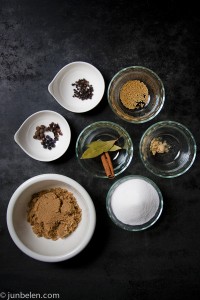Alton Brown No Saltpeter Corned Beef
I was going through the listing of things I need for making corned beef brisket and was surprised to discover 1 odd ingredient:
salt peter,
the course of potassium nitrate, KNO3, that occurs naturally, used in the manufacture of fireworks, fluxes, and gunpowder.
I checked the recipe twice and thought I read information technology right. Salt peter has been used for the longest fourth dimension to cure meats. It gives the meat its distinct red color. Just, seriously, I wouldn't add chemicals in my food only to make information technology look pretty. After all, the utilize of table salt peter has already been discontinued ever since modern nitrates have been developed. This is actually a dandy example that demonstrates why I am a huge fan of making food from scratch at home: you know exactly what goes in your food.
Corning is a technique for preserving or curing meat by soaking information technology in alkali for long periods of time.
"Curing, no thing which method, involves several processes, the most significant of which is denaturing of the proteins. This happens when salt is introduced to the meats proteins. Proteins are coils and the common salt causes the proteins in the muscle fibers to unwind and blot the extra water trapped inside. Water inside your meat spells trouble considering bacteria love water and then eliminating information technology by salting and drying allows for longer storage." – Chef's Corner
And then what adept stuff goes in to the corning solution?

Corning the Beef Brisket, adapted from Alton Brown's Skilful Eats
1 (iv- to five-lb) beefiness brisket, trimmed
ii quarts water
1 loving cup kosher salt
ane/2 cup brown sugar
i cinnamon stick, broken into several pieces
1 tsp mustard seeds
ane tsp black peppercorns
eight whole cloves
8 whole allspice berries
12 whole juniper berries
ii bay leaves, crumbled
i/2 tsp ground ginger
2 pounds ice (optional)
Identify the water into a large stockpot along with common salt, sugar, cinnamon stick, mustard seeds, peppercorns, cloves, allspice, juniper berries, bay leaves and ginger. Cook over loftier rut until the salt and sugar take dissolved. The aromatic fragrance of the spices is simply astonishing.
Remove from the heat and add the water ice. Stir until the water ice has melted. Ice is added to cool downward the solution but you can totally skip this and just refrigerate the alkali until it reaches a temperature of 45 degrees F.
One time it has cooled, place the brisket in a two-gallon zip top bag and add the brine. Seal and lay flat inside a container, embrace and place in the refrigerator for at least 10 days. Check daily to brand certain the beef is completely submerged and stir the brine. If you don't have a huge zip peak handbag, alkali the brisket in a large tupperware container and make sure to flip the brisket each twenty-four hours to make sure that all of the brisket comes in contact with the brine.
Cooking the Beef Brisket
1 small onion, quartered
1 large carrot, coarsely chopped
1 stem celery, coarsely chopped
After at to the lowest degree 10 days, remove the brisket from the brine and rinse well nether absurd water. Place the brisket into a pot just big plenty to hold the meat, add the onion, carrot and celery and cover with water. Set over high heat and bring to a eddy. Reduce the estrus to low, cover and gently simmer for 2 one/ii to 3 hours or until the meat is fork tender.
Remove from the pot and thinly piece across the grain.
There are so many wonderful things you can practice with corned beef. On the top of my list is a tasty Reuben sandwich: thin slices of corned beef with sauerkraut, Swiss cheese and K Island dressing on lightly toasted rye breadstuff. And a personal favorite is crusty corned beef hash with eggs.
Related
Source: http://blog.junbelen.com/2010/03/15/how-to-make-corned-beef-brisket-nitrate-free-at-home/
0 Response to "Alton Brown No Saltpeter Corned Beef"
Post a Comment